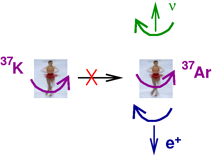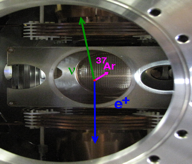 TRIUMF's Neutral Atom Trap, or TRINAT, uses the pressure of laser light to trap isotopes long enough for researchers to measure how they decay. TRINAT examines the decaying particles as they change from one state to another to address possible holes in the Standard Model of particle physics. Experimenters are currently looking at data from potassium-37 (K-37) isotopes, which decay into Argon-37 (Ar-37), a positron (antiparticle of the electron), and a neutrino.
TRIUMF's Neutral Atom Trap, or TRINAT, uses the pressure of laser light to trap isotopes long enough for researchers to measure how they decay. TRINAT examines the decaying particles as they change from one state to another to address possible holes in the Standard Model of particle physics. Experimenters are currently looking at data from potassium-37 (K-37) isotopes, which decay into Argon-37 (Ar-37), a positron (antiparticle of the electron), and a neutrino.
TRINAT uses laser light both to trap K-37 and to ensure a uniform spin direction as they decay. To achieve this, circularly polarized laser light is shone on the atoms of K-37 until they absorb enough light to be spinning in the same direction. The atomic spins are 'pointed up'; the same way a figure skater spins around an axis pointed up (see Figure 1 above).
One odd feature of the Standard Model is that a decaying atomic nucleus only emits neutrinos that are left-handed, meaning the neutrino only spins in a counter-clockwise fashion. Researchers are looking for evidence of neutrinos that spin in the other direction. If found, this would point to gaps of knowledge in the Standard Model thus creating new understanding in subatomic particle physics.
In the experiment, potassium-37 decays to a twin isotope, Ar-37. Potassium-37 already spins at top speed and Ar-37 cannot spin any faster. If the neutrino and positron are emitted upwards and downwards with their known spin directions, they would prompt Ar-37 to spin faster. Since it can't, this decay pattern is forbidden. If this pattern were observed, it would imply discovery of a new interaction producing wrong-handed neutrinos.
In December 2012, experimenters finished a multi-year effort to upgrade the TRINAT apparatus and collect accurate data. For instance, in order for the experiment to operate successfully the environment must be precisely controlled. Since atoms have a magnetic moment, like a compass needle they will try to point in the direction of any stray magnetic field, experimenters must also control the local magnetic field very carefully to make sure the atoms only 'point up'.
Furthermore, since a neutrino can travel a light-year in lead without interacting, TRINAT deciphers the direction of the neutrino by calculating the momentum of the recoiling Ar-37 and the positron. The total momentum must be zero as the K-37 started at rest in the trap. This works because the laser trap is very shallow and all the particles in the energetic decay escape freely.
To increase the accuracy of the experiment, one focus of the TRINAT team is to improve the degree of spin polarization. Essentially, the team:
- Built a bigger vacuum chamber thereby minimizing the effects of the natural magnetic field outside of the experiment, including the walls,
- Procured better materials and ensured little or no magnetization caused while welding, and
- Improved the quality of circularly polarized light.
Specifically, the upgrades have increased the amount of spin polarization achieved and its accuracy more than one per cent, from 98 +/- 1% accurate to 99.5 +/- 0.5% accuracy. The ultimate goal is to eventually achieve 99.9 +/- 0.1% accuracy, so the experiment could measure if a wrong-handed neutrino is emitted even one in a thousand times. There are particle physics models beyond the Standard Model where this is predicted; such evidence would help high-energy collider experiments at the LHC interpret any more direct evidence for new physics that they may detect.
The error on the angular distribution from counting statistics from the December experiments will be about one percent, while the systematic errors from experimental defects are still being extracted from the data and from further trap measurements with naturally occurring isotopes. The experimenters have deliberately not looked at the results until they finish all analysis details to avoid being overly reassured if they accidentally are getting the standard model answer (or overly excited if they aren't).
The present experiment is the Ph.D. thesis of a Texas A&M student, Spencer Behling, under the guidance of Prof. Dan Melconian, while the trap itself is an M.Sc. thesis for UBC student Melissa Anholm; the circularly polarized light was mainly improved by co-op undergrads, especially Scott Smale from SFU, and much of the apparatus upgrade was led by TRIUMF postdoctoral student, Alexandre Gorelov. Further experiments would be done as two more Ph.D. theses. The experiments conducted in December 2012 came from Texas A&M University, the University of Manitoba, Tel Aviv University, and TRIUMF.
 | Figure 2. Illustrated here is the atom trap apparatus before it is put under vacuum. The trapped atoms would collect in a 1 mm-sized cloud at the red dot, and decay by emitting an energetic positron (e+), a recoiling atomic ion, and a neutrino. Copper water-cooled magnetic field coils for the trap are wound at top and bottom near the location of the beta detectors. The Ar-37 recoils are collected in a uniform electric field, produced by titanium and glassy carbon electrodes. The elliptical holes are for the trap laser beams (not shown). The viewport looking in is 15 cm in diameter. |
-by John Behr, Research Scientist (TRIUMF) with edits by Melissa Baluk
